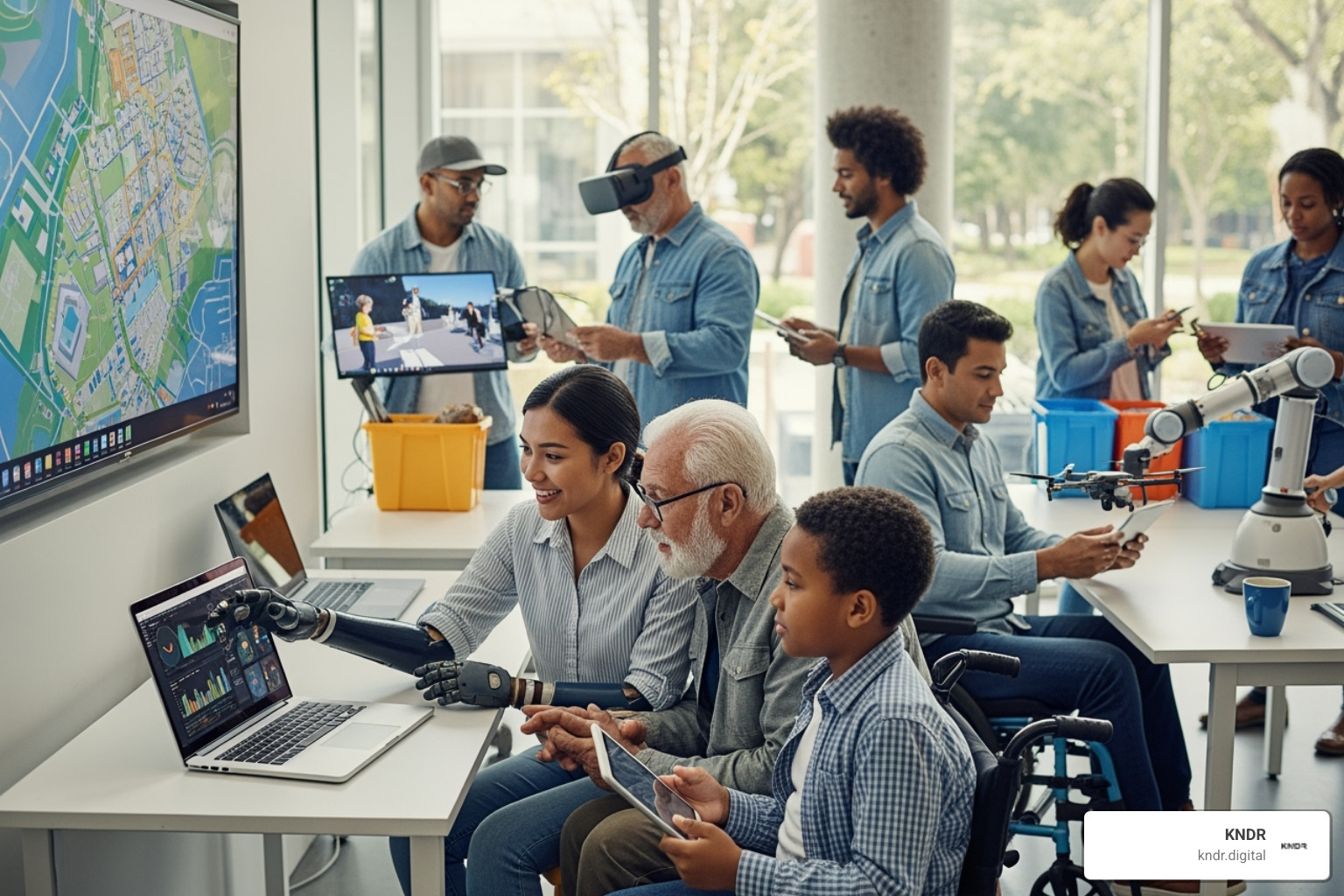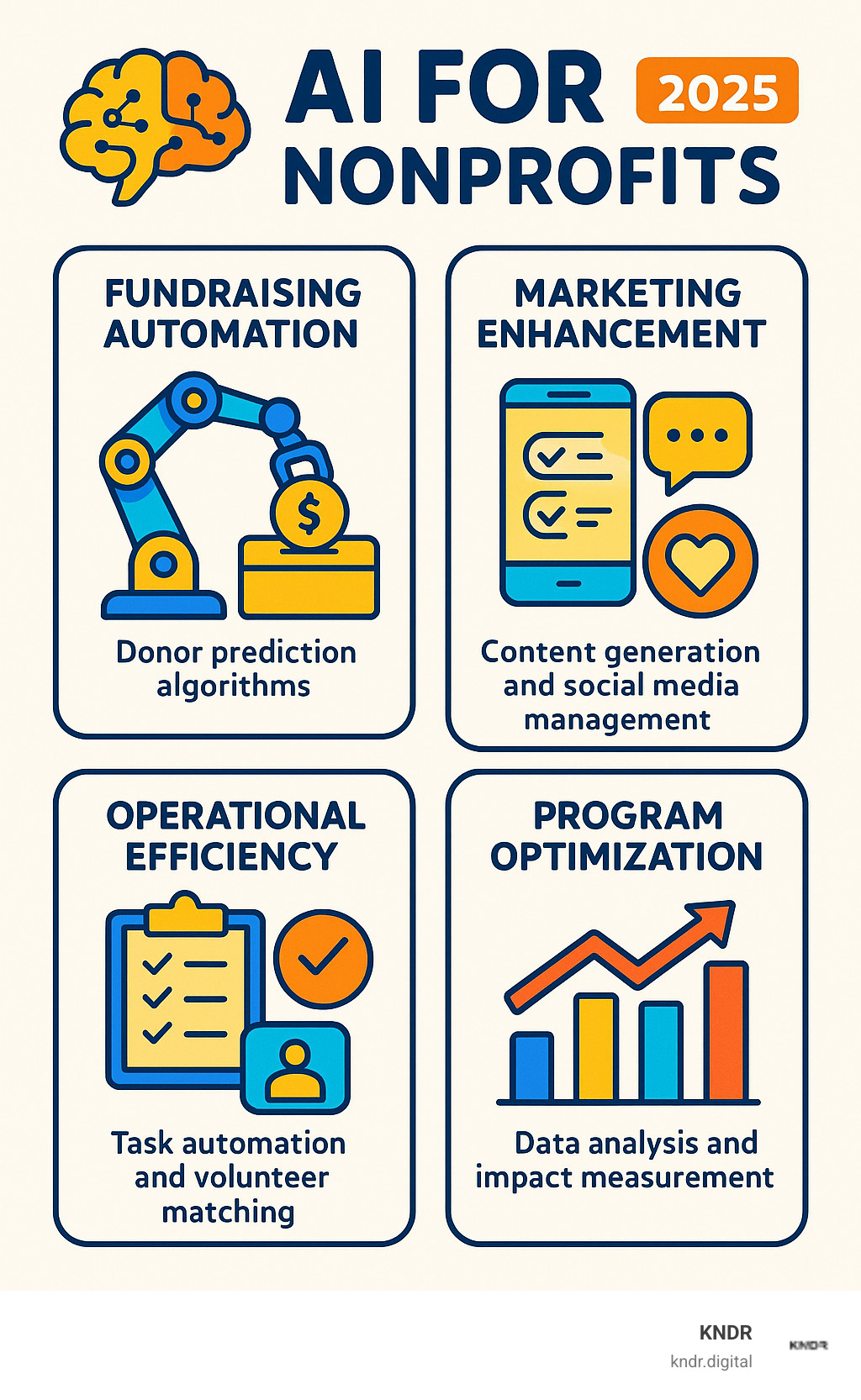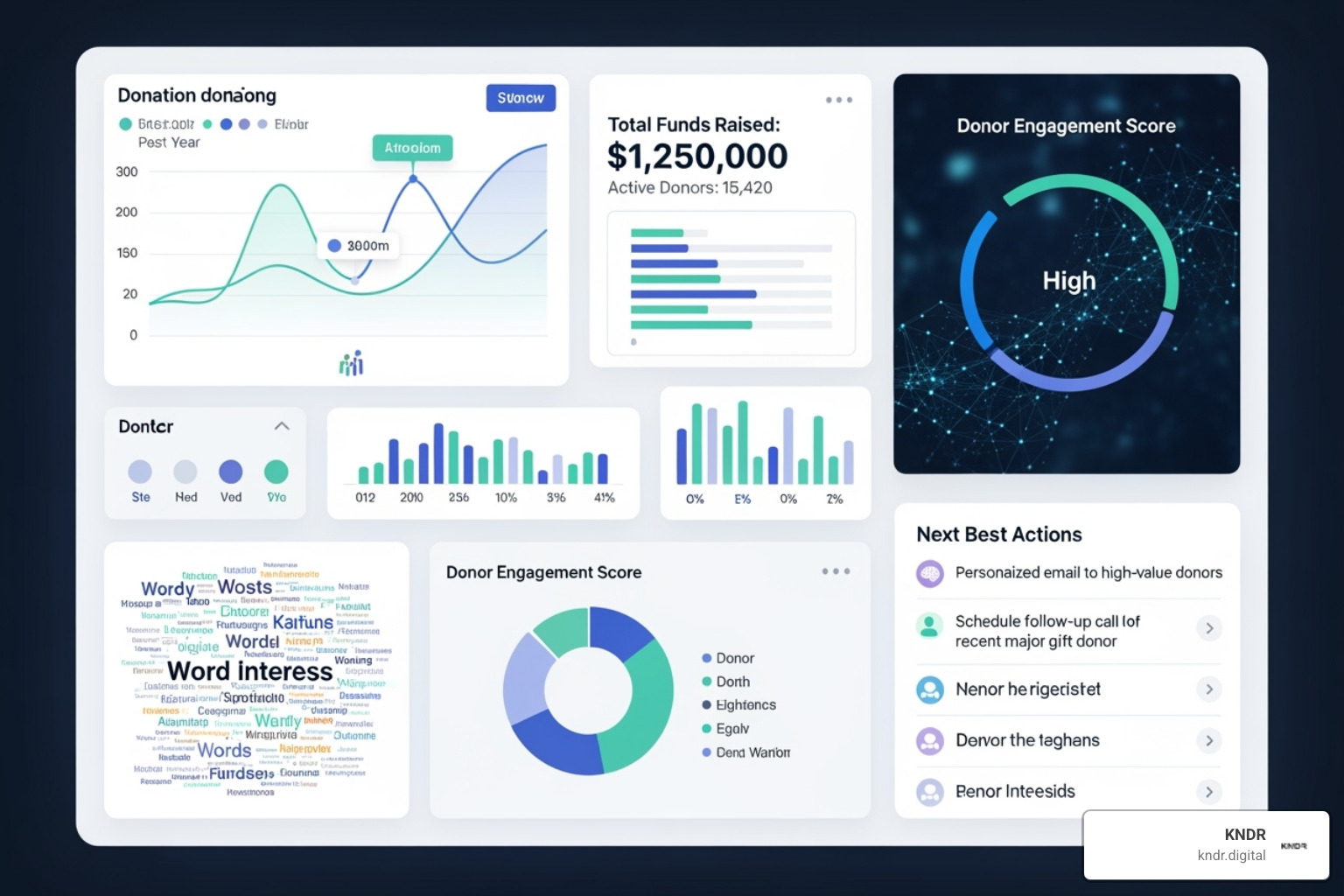The Future is Now: Essential AI Tools for Nonprofits

Why AI for Nonprofits is Revolutionizing the Social Sector
AI for nonprofits is changing how mission-driven organizations operate, fundraise, and engage with their communities. Here's how artificial intelligence can help your nonprofit:
- Boost fundraising through personalized donor outreach and predictive analytics
- Automate routine tasks like data entry, scheduling, and report generation
- Improve marketing with AI-powered content creation and social media management
- Improve operations through volunteer matching and program evaluation
- Increase efficiency by streamlining workflows and reducing manual processes
The nonprofit sector is actually leading the charge in AI adoption. As of 2024, 58% of nonprofits have incorporated AI into their communications, and 68% use it for data analysis - both rates that exceed for-profit implementation.
This shift makes perfect sense. Nonprofits face unique challenges: limited budgets, small teams, and the constant pressure to do more with less. AI offers a solution that can amplify your impact without expanding your staff or budget.
The results speak for themselves. Organizations using AI tools report remarkable improvements:
- The Humane Society saw a 20% increase in open rates using AI-powered appeals
- The Joy Givers Welfare Association achieved a 40% improvement in campaign ROI through AI-driven donor analysis
- Many nonprofits report 25% increases in volunteer retention using AI matching systems
But here's what's really exciting: we're just getting started. The tools available today are more accessible, affordable, and powerful than ever before.
As Mahir Iskender, CEO of KNDR.digital, I've helped dozens of mission-driven organizations implement AI-powered marketing and digital fundraising systems that drive measurable growth. Through my work with AI for nonprofits, I've seen how the right technology can transform struggling organizations into thriving engines of social change.

Important AI for nonprofits terms:
The Transformative Benefits of AI for Nonprofits
Think of artificial intelligence as your organization's most dedicated volunteer - one who never gets tired, never takes a day off, and gets smarter with every task. AI for nonprofits isn't about replacing the human heart of your mission; it's about amplifying your impact by handling the heavy lifting so your team can focus on what matters most.

The most immediate benefit is operational efficiency. Nonprofit teams are often stretched thin with administrative tasks. AI acts as a powerful assistant, automating routine work like data entry, scheduling, and report generation. This frees your staff to focus on building relationships and delivering your mission.
AI also transforms your organization into a data-driven powerhouse. It analyzes donor and program data in seconds, revealing insights that would normally take weeks to find. This leads to better decisions, more effective programs, and stronger proof of impact for funders.
The real game-changer is in fundraising outcomes. Following the 80/20 rule, AI helps identify and nurture your most crucial donors with precision. Instead of generic appeals, you can send personalized messages that resonate with each supporter, boosting engagement and revenue.
When nonprofits accept AI for nonprofits, they're not just working harder - they're working smarter. Resources get allocated where they'll make the biggest difference, and every dollar raised goes further toward your mission.
Supercharging Fundraising and Donor Engagement
AI enables powerful personalized donor communication. It tracks a donor's full history—giving, email opens, social media likes—to help you send messages that make them feel seen and valued, rather than just another name on a list.
The Humane Society found this to be true. By using AI to analyze donor behavior and craft appeals, they achieved a 20% increase in open rates, connecting thousands more people to their cause.
Predictive analytics takes this further by forecasting which donors are likely to give again, upgrade, or become major supporters. This allows your team to focus their energy on the most promising prospects instead of making cold calls to your entire database.
Donor segmentation becomes effortless as AI groups supporters by shared behaviors. This allows you to send targeted appeals—for example, different messages for animal lovers versus environmental advocates—making every communication feel relevant and personal.
AI is also invaluable for major gift identification. It sifts through data to find supporters with the capacity and inclination to make transformational gifts who might not be on your radar yet.
Revolutionizing Marketing and Communications
Creating content that cuts through today's digital noise feels impossible sometimes. Your social media manager is burning out trying to post daily while also writing newsletters, updating the website, and somehow making it all feel fresh and engaging.
AI acts as a creative partner. Automated content creation isn't about robotic posts; it's about generating first drafts, brainstorming ideas, and adapting messages for different platforms. Your team provides the human touch and authentic voice while AI handles the initial work.
Social media management becomes strategic instead of a scramble. AI can schedule posts for optimal times, suggest hashtags, and identify resonant content. For example, The Joy Givers Welfare Association saw a 50% jump in online engagement by using AI to craft compelling narratives.
AI helps maintain momentum across video content, email newsletters, and social media campaigns, keeping your organization visible while your team focuses on mission-critical work.
Streamlining Operations and Program Management
Automating routine tasks like updating donor profiles, generating reports, and scheduling meetings is transformative. The hours saved allow your team to focus on mission-driven work they are passionate about.
Volunteer management improves significantly. AI matches volunteers to roles based on skills and interests, ensuring a better fit. The Joy Givers Welfare Association used AI matching to increase volunteer retention by 25%.
Grant writing assistance is another key benefit. AI can research funders, draft initial proposals, and tailor applications, handling the time-consuming early stages while your team provides the final strategy and touch.
Program impact analysis becomes more sophisticated. AI analyzes data to measure social impact, helping you understand what's working. This data-driven evaluation strengthens your case to funders and helps you continuously improve services.
Key Applications: How to Leverage AI in Your Nonprofit
Putting AI for nonprofits into practice is key to unlocking its potential. Rather than replacing your team, AI amplifies their impact. In practice, this means using AI for:
- Fundraising: Sifting through donor data to identify major gift prospects and segment supporters for targeted campaigns.
- Marketing: Generating fresh content for social media, drafting email newsletters, and adapting your message for different audiences.
- Operations: Automating CRM updates, answering common questions with chatbots, and streamlining administrative tasks.
- Program Delivery: Understanding community needs and allocating resources more effectively, like the International Rescue Committee's Signpost project, which uses AI to provide vital information to millions.

Essential Types of AI Tools for Nonprofits
The world of AI tools might seem overwhelming at first, but certain categories stand out as particularly valuable for nonprofits. Let's break them down in a way that makes sense for your mission-driven work.
Generative AI models are the rockstars of the AI world right now, and for good reason. These tools can create new content from scratch, whether you need text, images, or even video. ChatGPT excels at drafting everything from donor emails to grant proposals, and OpenAI offers special nonprofit rates that make it even more accessible. Google's Gemini brings similar capabilities with the added bonus of extensive nonprofit resources and support. Microsoft Copilot integrates seamlessly with the Office tools you probably already use, acting as your AI assistant across Word, Excel, PowerPoint, and Outlook. And if you need professional videos without the Hollywood budget, Synthesia lets you create compelling content with AI avatars.
AI writing assistants like Grammarly ensure your communications are polished and professional, catching not just typos but helping with tone and clarity. Meanwhile, AI-powered design tools such as Canva can generate unique graphics that make your campaigns stand out in crowded social media feeds.
For social media management, tools like FeedHive use AI to help you create, schedule, and optimize content for maximum engagement. No more guessing about when to post or what will resonate with your audience.
Predictive analytics platforms represent a different but equally powerful approach. Many platforms, some built specifically for nonprofits, analyze patterns in your data to predict donor behavior, identify major gift prospects, and help you understand not just who to ask for support, but how much to ask for and when.
Here's how these two main types of AI stack up for common nonprofit tasks:
| Feature | Generative AI | Predictive AI |
|---|---|---|
| Purpose | Create new content (text, images, video) | Analyze data to forecast future outcomes |
| Typical Tasks | Drafting appeals, social media posts, grant narratives, email campaigns, brainstorming, summarizing | Donor segmentation, identifying major gift prospects, forecasting giving, optimizing campaign timing, fraud detection |
| Data Focus | Learning from vast datasets to produce coherent output | Analyzing historical patterns and trends in specific datasets |
| Benefit | Saves time on content creation, sparks creativity, automates communication | Improves targeting, maximizes fundraising ROI, enables proactive decision-making, reduces risk |
| Example Tools | ChatGPT, Gemini, Microsoft Copilot, Synthesia | Specialized nonprofit fundraising platforms, custom AI models |
The key is understanding that both types serve different but complementary purposes. Generative AI helps you create and communicate, while predictive AI helps you strategize and target.
A Step-by-Step Guide to Implementation
Starting your AI for nonprofits journey doesn't have to feel like climbing Mount Everest. With the right approach, you can confidently introduce AI into your organization without overwhelming your team or breaking your budget.
Start by assessing your needs. Evaluate your current technology, data quality, and team comfort with digital tools. Use a framework like the AI Compass for Nonprofits™. Most importantly, define specific, measurable goals. Do you want to boost donor retention, streamline volunteer management, or speed up grant writing? Clear goals will guide your decisions.
Begin with a single pilot project. Don't try to do everything at once. Pick one area for a clear win, like personalizing email subject lines or automating thank-you messages. This allows your team to learn without being overwhelmed and provides concrete data to build on.
Invest in your team's learning. AI is only as good as the people using it. Use resources from Google for Nonprofits and Microsoft for Nonprofits. Foster an environment where staff can experiment and ask questions, allowing everyone to learn at their own pace.
Track your results to guide your next steps. Is the AI campaign increasing donations? Are you saving time? Be honest about what works. After a successful pilot, you can gradually expand AI to other areas, always prioritizing ethical and responsible use.
- Nonprofit Digital Change
Navigating the Challenges: Responsible and Ethical AI Use
While the benefits of AI for nonprofits are immense, implementing these powerful tools requires careful consideration and a strong ethical foundation. As organizations built on trust and dedicated to social good, nonprofits must approach AI with the same values that guide their mission work.

Data privacy sits at the heart of responsible AI use. Your nonprofit handles incredibly sensitive information - donor financial details, beneficiary personal stories, and confidential program data. When you introduce AI tools into this environment, you're essentially giving these systems access to your community's most private information. This means choosing AI vendors who prioritize security, implementing strong data encryption, and ensuring that donor information is never compromised or misused.
Algorithmic bias presents another significant challenge that many nonprofits don't initially consider. AI systems learn from historical data, and if that data reflects past inequities or limited perspectives, the AI will perpetuate those same problems. For example, if your donor database has historically been less diverse, an AI tool trained on this data might overlook potential supporters from underrepresented communities. This could actually work against your mission of creating positive social change.
The key to navigating these challenges lies in transparency and explainability. You should always understand how your AI tools make decisions and be able to explain these processes to your board, donors, and beneficiaries. If an AI system recommends targeting certain donor segments or suggests specific fundraising strategies, you need to know why it's making these recommendations.
Maintaining human oversight remains absolutely critical. AI should improve human decision-making, never replace it. The empathy, ethical reasoning, and mission-driven perspective that your team brings cannot be replicated by any algorithm. Every AI-generated recommendation should be reviewed by someone who understands your organization's values and can spot potential issues.
Creating AI governance best practices doesn't have to be overwhelming. Start by establishing clear policies about how AI will be used in your organization, what data it can access, and who's responsible for monitoring its performance. Prioritize robust data security measures and conduct regular reviews to check for bias in AI outputs. Most importantly, maintain transparency with your stakeholders about how you're using AI and why it benefits your mission.
Google provides excellent guidance on Responsible AI for nonprofits, offering practical strategies for ethical implementation. Microsoft has also developed an AI Governance Framework for Nonprofits that walks organizations through key considerations.
Implementing AI for nonprofits responsibly isn't just about avoiding problems - it's about building trust with your community and ensuring that these powerful tools actually advance your mission rather than undermine it. When done thoughtfully, responsible AI use strengthens your organization's integrity while amplifying your impact.
Frequently Asked Questions about AI in the Nonprofit Sector
When nonprofits first explore AI for nonprofits, I hear the same concerns come up again and again. Let me address the big three questions that keep nonprofit leaders up at night.
Will AI replace jobs at my nonprofit?
I get it – this fear is completely understandable. But here's the reality: AI is much more likely to improve your team's work than replace them entirely.
Think of AI as that incredibly reliable intern who never gets tired, never calls in sick, and actually enjoys doing data entry. AI excels at automating repetitive tasks like updating donor records, scheduling social media posts, drafting initial email templates, and generating basic reports. These are the tasks that often eat up hours of your team's day.
But here's what AI can't do: it can't comfort a grieving family, inspire a room full of volunteers, or make the nuanced decision about whether to pursue a challenging grant opportunity. Human empathy and decision-making remain irreplaceable in nonprofit work.
When your development coordinator isn't spending three hours manually updating donor information, they can spend that time having meaningful conversations with major donors. When your communications manager isn't stuck writing routine social media posts, they can focus on crafting compelling campaign stories that truly move people to action.
Is AI too expensive for a small nonprofit?
This is probably the second most common worry I encounter, and I have great news: AI doesn't have to break your budget.
The range of tools available today is incredible. Many powerful AI platforms offer free and low-cost options specifically for nonprofits. OpenAI provides discounted rates for qualifying organizations. Google and Microsoft both offer extensive AI resources through their nonprofit programs.
The secret is starting small. You don't need to revolutionize your entire organization overnight. Pick one specific challenge – maybe you want to improve your email subject lines or streamline volunteer scheduling. Test a simple AI tool for that one task and measure the results.
Focusing on high-ROI applications like Automated Fundraising Campaigns can actually save you money. If an AI tool helps you identify just two additional major donors per year, it has likely paid for itself many times over.
How do we ensure our donor data is safe when using AI?
Trust is everything in nonprofit work, so this concern makes perfect sense. Protecting donor information isn't just good practice – it's fundamental to your mission.
Choosing reputable vendors is your first line of defense. Look for companies with clear privacy policies, strong security track records, and specific experience working with nonprofits. Ask direct questions about how they handle your data.
Data encryption should be non-negotiable. Any AI platform you use should encrypt your information both when it's being transmitted and when it's stored. Anonymization techniques can add another layer of protection by removing personally identifiable information from datasets used for analysis.
Adhering to privacy regulations like GDPR or state privacy laws isn't optional. Make sure any AI tool you choose helps you stay compliant rather than creating new compliance headaches.
Most importantly, develop responsible AI frameworks within your organization. This means having clear policies about what data can be used, who has access, and how decisions get made. Regular security reviews and maintaining human oversight ensure you catch potential issues before they become problems.
The goal isn't to avoid AI because of these concerns – it's to implement it thoughtfully and securely so you can focus on what matters most: serving your community.
Conclusion: Your Partner in Amplifying Impact
The change is already happening. Across the nonprofit sector, organizations are finding that AI for nonprofits isn't just another tech trend – it's becoming an essential partner in creating lasting social change.
We've seen the remarkable results: nonprofits achieving 20% increases in open rates, boosting campaign ROI by 40%, and improving volunteer retention by 25%. But the real magic happens when AI frees your team from routine tasks, allowing them to focus on what they do best – building authentic relationships, crafting compelling stories, and making strategic decisions that drive your mission forward.
Think about it: when AI handles your data entry, your staff can spend more time with donors. When AI helps personalize your communications, your supporters feel truly seen and valued. When AI streamlines your operations, you can direct more resources toward the programs that matter most to your community.
The efficiency gains are impressive, but the deeper donor connections are changeal. AI doesn't replace the human heart of your work – it amplifies it.
At KNDR.digital, we've built our entire approach around this principle. Our results-based model – promising 800+ donations in 45 days or no payment – demonstrates our confidence in what AI-powered systems can achieve for nonprofits. We combine advanced automation with holistic digital strategies because we know that technology alone isn't enough. It's about creating systems that work seamlessly with your team's expertise and passion.
The future of nonprofit work is bright, and it's powered by the perfect partnership between human compassion and artificial intelligence. Whether you're a small grassroots organization or an established charity, AI tools are now accessible, affordable, and ready to help you achieve more than you thought possible.
Your mission deserves every advantage. Your community needs your impact to grow. And your team deserves tools that make their vital work more effective and fulfilling.


